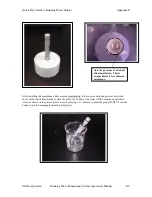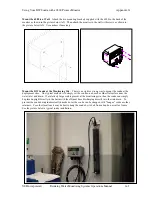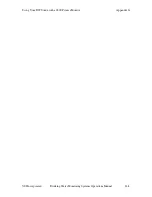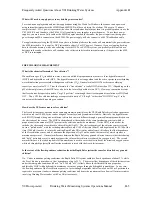
Using Your DW Sonde with a 6500 Process Monitor
Appendix G
YSI Incorporated Drinking Water Monitoring Systems Operations Manual
G-7
Under most conditions, it is best to calibrate all sensors except free chlorine with the
Sample and Hold
feature INACTIVE and then activate the feature just prior to logging to the start of a study which is sending
data to a SCADA system and the internal memory of the sonde at the predefined
Sample and Hold
interval
. However, it is acceptable to calibrate any parameters with an ACTIVE
Sample and Hold
feature as long as a certain precaution is followed. This precaution involves making certain that the sonde
has been in the flow cell and connected to a 6500 for at least one Sample and Hold interval prior to
implementing a calibration from the 6500 keypad. Thus, if the
Sample and Hold interval
is 15 minutes
and the sonde was attached to the 6500 at 15:00, you should wait until the 15:15 reading appears on the
6500 display prior to calibrating any sensor with the
Sample and Hold
feature active. As noted above, in
any case, you should wait for 1-2 hours, i.e. several Sample and Hold intervals, before calibrating the free
chlorine sensor whether or not the Sample and Hold feature is active.
NOTE CAREFULLY: FAILURE TO WAIT AT LEAST ONE SAMPLE AND HOLD
INTERVAL PRIOR TO CALIBRATING WITH THE SAMPLE AND HOLD FEATURE
ACTIVE IS LIKELY TO RESULT IN ERRONEOUS CALIBRATIONS. AS NOTED
ABOVE, IT IS BEST TO CALIBRATE ALL SENSORS EXCEPT FREE CHLORINE
WITH THE SAMPLE AND HOLD FEATURE INACTIVE AND THEN CALIBRATE
FREE CHLORINE AT A LATER TIME.
Carry Out Spot Checks of Accuracy and Recalibrate as Necessary
. You should confirm the accuracy
of your free chlorine readings relative to a DPD colorimetric analysis within one week of your deployment
and as often as possible thereafter. Although YSI’s extensive empirical testing program has indicated that
the sensor is capable of remaining within the accuracy specification for 60-90 days, we cannot guarantee
that the sensor will not be susceptible to some drift depending on the content of your drinking water.
Therefore, you should go to your deployment site as often as possible, perform a DPD colorimetric test of
the flow cell effluent and recalibrate the sensor from the 6500 display if significant drift is evident. If drift
in the same direction continues to be observed and/or if the free chlorine readings become jumpy, then you
should remove the free chlorine probe from the sonde, recondition it, install a new membrane, and activate
the sensor as described in Section 2.6.1 of the Drinking Water Sonde Manual. It is important to remember
that the accuracy specification provided for the free chlorine sensor (+/- 15 % of the reading or 0.05 mg/L,
whichever is greater) does not include long term drift even though our empirical studies in several water
samples show that the specification can be met for up to 60 day deployments. The extent of the drift of
your free chlorine sensor will depend on several factors including the species in your particular drinking
water and whether the membrane was properly installed.














































